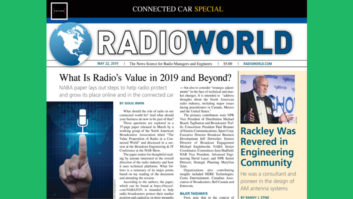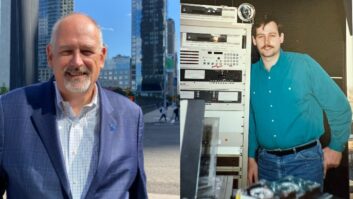
Credit: Jim Peck
SARASOTA, Fla. — Ron Rackley was a lifelong supporter of AM radio, and perhaps no broadcast engineer ever had a deeper understanding of AM antenna system design, according to his industry friends. That’s why his loss is deeply felt by the broadcast engineering community.
Rackley died unexpectedly at his home on April 12. He was 66.
The veteran consulting engineer was a champion of AM radio and its revitalization efforts. He worked on high-power medium-wave antenna systems around the world and served as a consultant to USA Digital Radio during the early stages of in-band, on-channel digital testing.
AM broadcast system design and optimization was Rackley’s passion, according to colleagues.
He graduated from Clemson University with an electrical engineering degree and worked as a radio station chief engineer and as an antenna designer for Kintronic Labs Inc. In 1983, he co-founded du Treil-Rackley Consulting Engineers, with Bob du Treil, which later merged with A.D. Ring & Associates to form du Treil, Lundin and Rackley.
“Ron was one of the true giants of broadcast industry. Before computer technology became widely implemented, there was real art to the design and tuning of directional AM antennas,” said Bob du Treil Jr., principal at du Treil, Lundin and Rackley. “Once computers became more widespread and powerful, Ron was instrumental in developing technology that would allow for numerically calculating the actual drive point impedances. This was a huge leap in capability.”
Rackley had announced his semi-retirement from the firm earlier this year.
He grew up in Greenville, S.C., and worked as a duty operator for several local AM radio stations while still in high school. His first job was in 1968 at WHYZ(AM), a 50 kW daytime station in Greenville.
[Rackley on Synchronous AM Boosters]
“I had plenty of time to read various engineering reports and study contour maps while on duty,” Rackley told Radio World during an interview in 2006 about his receipt of the NAB Engineering Achievement Award, shared with his friend Ben Dawson. “Radio always seemed like magic to me. It seemed less like magic after I took mathematics in college. … I can’t recall a time when I wasn’t interested in radio.”
Speaking with Radio World in April of this year, Rackley said he recalled taking apart his family’s “big wooden” RCA radio at the age of three.
“Fortunately, an uncle who knew about radio was able to put it back together and get it working. It was probably good that we hadn’t gotten our first TV set yet,” he said.

Courtesy John Warner
Rackley was a pioneer in developing computer modeling methods to improve the performance of AM antennas for stereo and digital transmission and to optimize filtering system designs for diplexing stations to share transmitter sites, according to industry observers.
He was also deeply involved in the FCC rulemaking that established Method of Moments computer modeling as the standard way to prove that AM directional antenna systems work correctly, greatly simplifying the requirements for licensing them.
TOWERS INDUSTRIAL PARK PROJECT
One of many career highlights was his work on a complex AM antenna design in Los Angeles called the Towers Industrial Park project.
“It involved constructing two industrial park buildings totaling something like 500,000 square feet under the five towers of the old KTNQ directional antenna system,” he said in the April interview. It required that the buildings be constructed with shielding to protect the areas inside from excessive radio frequency exposure levels and interference to electronic systems while at the same time providing a ground plane for the AM antenna system without disturbing of the KTNQ day and night directional antenna patterns.
“A few years later, I designed a way for the station that is now known as KEIB to move to the site and share the same five towers. The two 50,000 watt stations are now diplexed there,” Rackley said.
“HE DESERVED EVERY WORD OF APPRECIATION”
Touching tributes appeared quickly following his death. His daughter Elizabeth posted to her father’s Facebook account: “My dad was definitely the most intelligent person I have ever known. He did work in his field of electrical engineering that only a handful of people in the world were capable of, and was renowned for it. I will remember my father as an incredibly wise and loving father, who always knew what was best and who loved and appreciated his family. I have annoyed so many people bragging about my dad, and I have no shame for it. He deserved every word of appreciation,” she wrote.
Ben Dawson, president of Hatfield & Dawson Consulting Engineers, wrote to Radio World: “Ron was simply one of the finest people I have ever known. He was kind, thoughtful, generous, honest and self-effacing. And of course he was a brilliant engineer. Because we worked together on projects for many years all over the world, taught classes together, collaborated on comments to FCC rulemakings, and traded ideas and thoughts about all sorts of things besides our engineering work, I can say that I’ve never had a better friend.”

Credit: Jim Peck
Colleagues said Rackley attended the NAB Show in Las Vegas in April, visiting vendor booths and participating in meetings. He’d been a regular at broadcast engineering conferences, friends said. Even though he was a “self-professed introvert uncomfortable speaking in front of crowds,” Rackley delivered countless speeches to radio engineers on how to troubleshoot and maintain AM antenna systems through the years.
[Remembering Ron Rackley]
“I’ll do it if I can help other engineers understand what AM is all about. Professionals are supposed to share information and to share knowledge,” he told Radio World at one point.
David Layer, NAB’s VP of advanced engineering, said, “It was devastating news that Ron Rackley had passed. I am so glad I was able to see him [in April] at the NAB Show and of course now wish I had spent more time with him. Ron was one of the gentlest souls I’ve ever encountered, a true gentleman and scholar, his brilliance as an AM broadcast engineer was world-renowned. He will be greatly missed by me and I expect everyone who knew him.”
Tributes have come from many across the broadcast engineering community.
“Superb engineer, raconteur par excellence, exemplary Christian,” said Karl Lahm, a consulting engineer with Broadcast Transmission Services. “That was Ron Rackley. And to say he was a character would be an understatement.” Ron “always had a good story, many involving less-than-optimal technical situations he had encountered over the years.”
Dave Stewart, consulting engineer with Moving Target Consulting Works, worked with Rackley on AM projects while at Univision Radio. He said, “Ron was great as an expert and great as a human being. He was easy to work with and generous with his expertise. He was decent and principled. There are tips and tricks I use every day that Ron showed us.”
[Ron Rackley on All-Digital AM Radio]
Rackley was known for his wit and was often able to infuse complex topics with humor.

Fred Greaves, former DOE for Susquehanna Radio, recalled working on the new directional system at WQBA(AM) in Miami. “We would get back to the hotel early in the morning and the ice machine was always empty. Ron took out a 3×5 card and neatly wrote, ‘Please do not urinate in the ice machine’ and taped it to the machine. He quietly said to me, ‘We’ll have ice tomorrow night.’ When we got back to the hotel the following night, the ice machine was completely full.”
In April, Rackley told Radio World he was beginning to appreciate his semi-retirement. “It feels good being off what I call the billable hour’s treadmill that comes along with professional practice that I’d been running on for decades. I’m going to keep enjoying life.”
David Elehalt of Telco Communications best summed up the industry’s sense of loss when he wrote: “What will AM radio do without him?”
Rackley is survived by his wife Dorothy and four children. Rackley’s funeral service was planned for mid-May in Lakewood Ranch, Fla. According to his obituary, a celebration of Rackley’s life, which will be open to the broadcast engineering community, would be planned for a later date.







